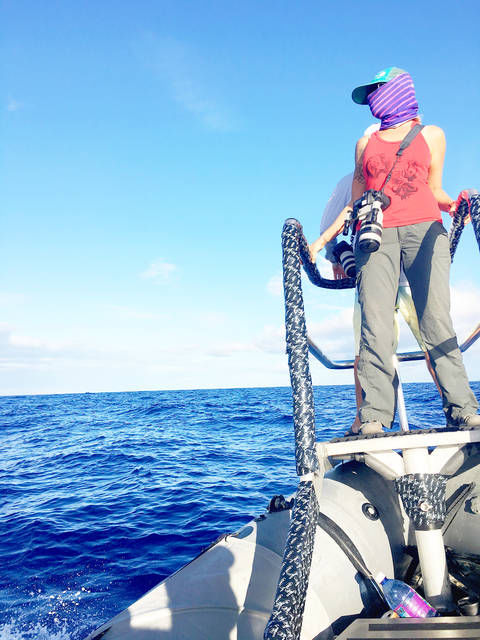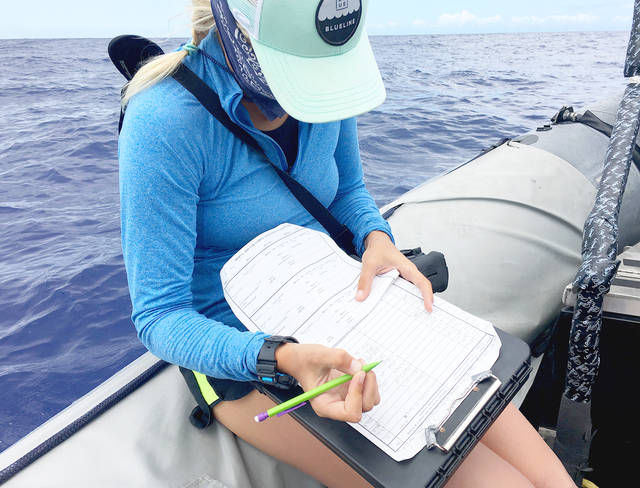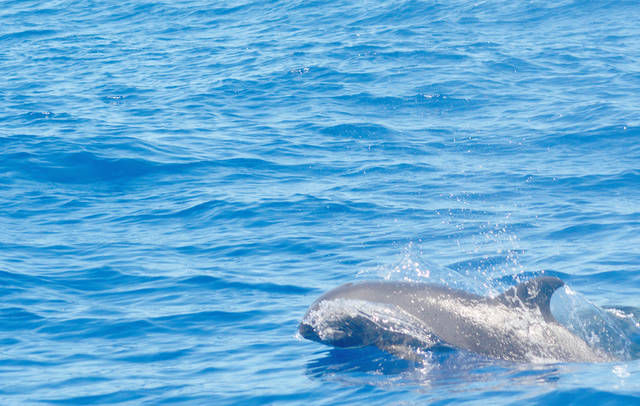KEKAHA — Researchers encountered something new off the coast of Kauai during an 11-day August field project — a probable hybrid between a melon-headed whale and rough-toothed dolphin. “It was side by side with a melon-headed whale as a pair,
KEKAHA — Researchers encountered something new off the coast of Kauai during an 11-day August field project — a probable hybrid between a melon-headed whale and rough-toothed dolphin.
“It was side by side with a melon-headed whale as a pair, which was strange because it’s unusual to see such a small group,” said Robin Baird, who headed up the project with Cascadia Research.
Melon-headed whales are a rare sight off Kauai because the population that hangs out around the island cruises throughout the entire archipelago, as opposed to the resident population that lives off the Big Island.
In addition to the probable hybrid, the research team encountered a group of about 200 melon-headed whales during the project, which started Aug. 4.
“It’s unusual off of Kauai, for sure,” Baird said. “And we were able to get a biopsy of the probable hybrid and it’ll be easy from the genetics to say what species (it is).”
The coloring of the probable hybrid, nicknamed Oreo by the crew, is blotchy and reminiscent of the coloring of a rough-toothed dolphin.
“There are no other species on Kauai that have the blotchy pattern,” Baird said.
The coloring, combined with a gently sloping head shape, indicates a cross between a melon-headed whale and rough-toothed dolphin.
Tracking the movements of target species — like melon-headed whales — before, during and after a Navy Submarine Commanders Course was one of the two main goals of the Cascadia Research project.
To do that, researchers deployed satellite tags that track movements of the animals.
Six were deployed during the August project. Two were attached to rough-toothed dolphins, two were deployed on melon-headed whales, and two were deployed on spotted dolphins.
It was the 10th day in the field when researchers finally tagged the two melon-headed whales, after their first encounter with the group.
“It’s perfect timing that we get these tagged because they are a species known to be sensitive to sonar,” said Daniel Webster, research associate with the project, on their last day.
He continued: “We saw them yesterday, late, and we stayed out even though the conditions weren’t perfect, so we could tag them and get some samples.”
And while tagging the melon-headed whales was a hailed a success, Baird says one of the real highlights was tagging the two spotted dolphins.
They were the fifth and sixth spotted dolphins tagged of Hawaii since Cascadia Research started tagging them in 2015, and the second and third tagged off Kauai.
“Spotted dolphin tags are the ones we’re getting the most completely new information from,” Baird said.
The dolphins were tagged on Aug. 10. One of the two spotted dolphin tags has already fallen off. They are from the same group, though, so researchers say they are still getting valuable information.
Tracking movements in relation to the deployment of sonar was one of the main goals of the project, and that’s where nature didn’t cooperate with scientists.
By the time the Navy Submarine Commanders Course started, all of the animals that were tagged had left the area and were well to the south of the Pacific Missile Range Facility.
“That’s just luck of the draw, really,” Baird said. “We do what we can from our end, but our success is driven by weather conditions and behavior (of the animals).”
But the data gathered during the project was very valuable, scientists say. In addition to tagging, observers took more than 38,000 photos and researchers collected 11 genetic samples.
“The last time melon-headed whales were tagged off Kauai was in 2008,” Baird said. “And getting a biopsy of that probable hybrid was a highlight.”
The team also started a community outreach project, distributing pocket-sized cards with information on target species and how to photograph them.
Target species are false killer whales, short-finned pilot whales, melon-headed whales, pygmy killer whales, killer whales, dwarf sperm whales, Cuvier’s whales and Blainville’s beaked whales.
Also on the list are rough-toothed, Risso’s and bottlenose dolphins.
“We use the photos ocean users send us because sometimes we only make it out there once a year,” Baird said. “If folks get photos and send them to us, we can continue to add to what we know.”
Send cetacean photos to hawaii@cascadiaresearch.org and include date and location of sighting.
Info: www.cascadiaresearch.org/projects/hawaii.




